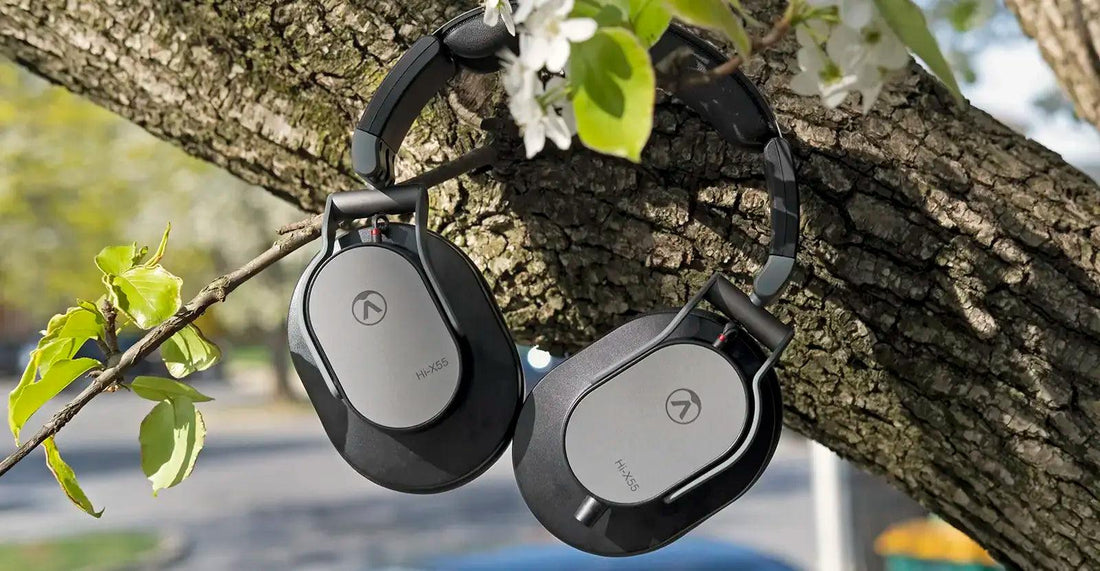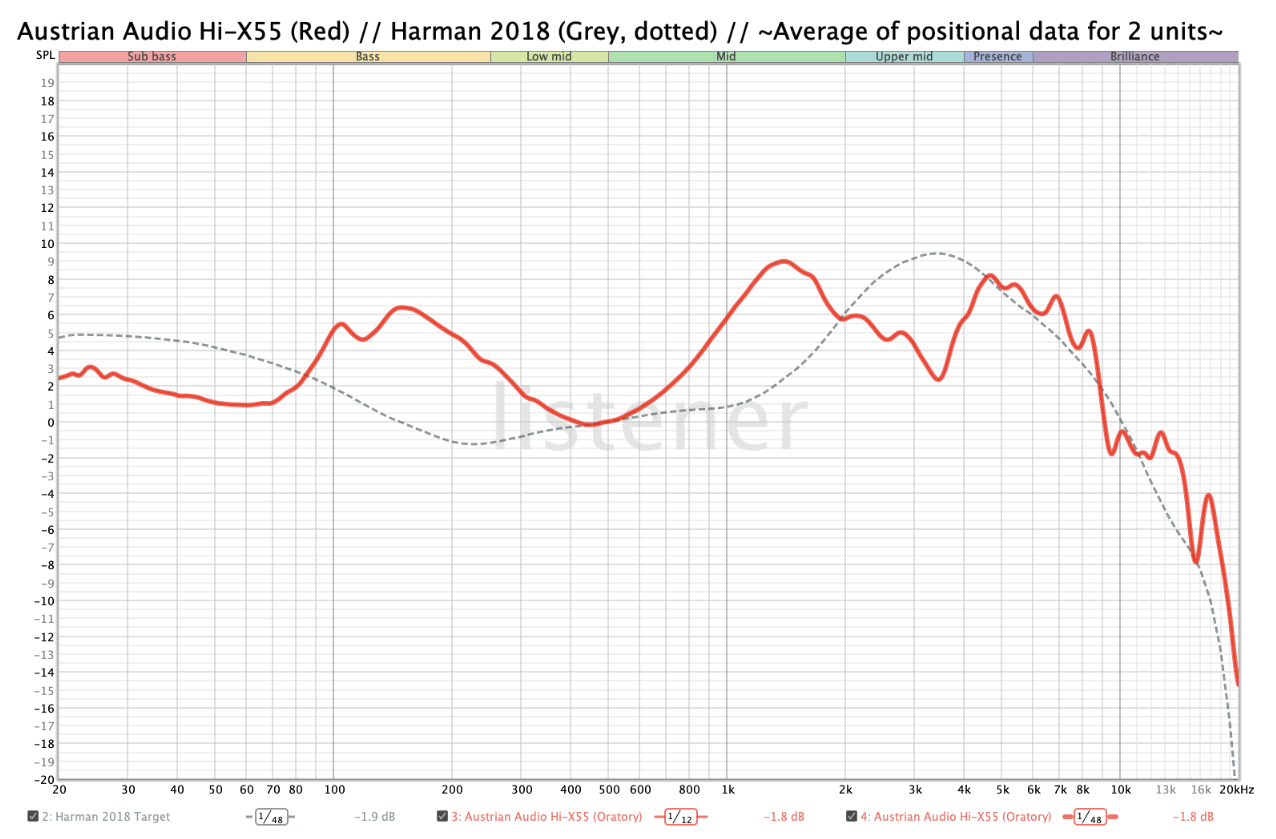Austrian Audio Hi-X55: The Comeback Kid and the Closed-Back Curse

Ahh, the closed-back headphone. The gear chosen by the commuter looking for a slice of silence in a busy world, and the tool of choice for musicians needing an honest monitor for tracking and creating music.
I’ve always loved closed-back headphones… regardless of the fact that they are often the most sonically-compromised headphones out there.
The Hi-X55, Austrian Audio’s first headphone after they were born amid the restructuring of AKG, claims to be a headphone that rises to the challenge of these needs. As a brand-new company, Austrian Audio had tons to prove. They immediately gave themselves a herculean task, one that even the more established brands have a hard time getting right: making a good closed-back headphone.
In my view, they failed.
However, for a first offering there’s a few things to be excited about here. Enough so that while I might not like this headphone, I can’t help but be a little excited to try Austrian Audio’s subsequent offerings. Let’s talk about why.
What we like
- Class-leading build quality and comfort
- Excellent passive isolation
- Sleek-looking and functional industrial design
What we don’t like
- Underperforming sound quality
- Lack of included accessories
- Price
Build, Accessories and Comfort
While the unboxing experience is lackluster at first, as soon as the headphone is picked up, the user is met with a surprisingly light, well-built headphone, replete with metal, plush foam, and a quasi-futuristic aesthetic.
Putting it on the head, the first noticeable thing is that the headband extension arms click incredibly satisfyingly. This doesn’t mean much in use, but I do love it. The headband padding is the exact right amount of plush, and the earcups are big, ovular, well-padded, and extremely deep. My ears don’t touch anything in the front volume and clamp is sufficient but not overbearing in the slightest.
Included accessories are scarce. All you get is the headphone itself, as well as a 10-foot threaded 3.5mm cable, with the 6.35mm adapter attached out of the box. The cable is terminated in a proprietary locking 2.5mm connector on the headphone end.

If any aspect of the headphone’s performance justifies its price tag, it’s definitely the build and comfort, where it bests any other passive closed-back headphone I’ve yet tried, save for maybe Sennheiser HD 820 or the ZMFs. It’s really quite special, at least on my head. However, a word of caution to the reader: I’ve only spent roughly 2 weeks with the unit I have on hand, so while I feel justified in my enthusiasm about the build here, only time will tell if it actually has longevity.
Frequency Response
The sheer level of target avoidance here is almost as impressive as the target adherence of old favorites like Sennheiser’s HD600. It dips where it should peak, and peaks where it should dip.
Hi-X55 is kind of a mess, tonally. I can pretty confidently say there’s not a single redeeming factor to the tonality here.
This graph is made with data provided by Oratory1990:

Measured on a GRAS 43AG. Data is smoothed to 1/12 octave and is an average of multiple seatings of 2 different units. Positional variation on this headphone was quite significant, so for that reason (and others), the measurement as shown may deviate from response on the user’s head.
Bass
The bass character makes my extremely sub-bassy songs (like Yesterday’s Pain by Lorn) sound downright anemic, I assume due to the balance of the relatively tame sub-bass region versus the massive boost in the upper bass. There’s enough of a delta here that it might as well roll off at 120Hz entirely. Bass is not a player here, and it sounds especially eerie because the seal on my head is fully intact, so my brain expects bass that it never really receives.

Midrange
The midrange ties for the worst I’ve ever heard with United Airlines complementary earphones. These sound like they reproduce solely 1-2kHz, and everything between 300-1kHz and 2-3kHz is missing. Not de-emphasized, gone.
Horns sound like they’re playing out of an iPhone in a SOLO cup. Electric guitars sound hilariously forward in overall volume (and in staging), but absolutely devoid of textural intensity save for the ~4kHz region. Everything in the midrange is plasticky in texture, and unceremoniously shoved in your face. It’s upsetting.
Kick drums are extremely small and boxy, snares sound like shakers, stick clicks are instantly fatiguing. The midrange balance ruins basically anything you play through it—but especially vocals.
Generally, if there’s a problem with a headphone, vocals are the first place I notice a problem… and Hi-X55 makes vocals impossible to ignore for all of the wrong reasons. Vocals are unnatural and nasal, to the point where I’d legitimately rather listen to an iPhone in a SOLO cup.
Treble
Cymbals sound mostly intact, relative to how thrashed everything else is. Perhaps the idea was that, with everything below 5kHz already being so weird, that it might make sense to leave the treble a little over-boosted, perhaps to take attention away from how unnatural everything below it is.
If we more seriously unpack the treble response here, the main problem is a mid-treble elevation causing things to sound hashy and thin. Sibilance gets pushed like no one’s business, and the air is bordering on being immediately fatiguing. However, given how much of a nightmare the midrange and bass are, there’s literally nothing that could’ve been done in the treble to integrate the frequency response as a whole into a tuning that makes sense.

Technicalities
Dynamics—whether they be “macro” or “micro”—are almost entirely fenestrated. It’s an uncanny experience, because in most closed-back headphones (even the cheap ones), there’ll usually be a good amount of contrast between bass and low-midrange that lends to the sound being more intense and punchy-feeling.
However, on Hi-X55 factors like weight, size, and punch are all so completely absent that I was left with only an uncomfortable feeling like I was being bullied by a four-year-old wielding a wet noodle as their weapon of choice. The feeling of tactile contrast in sound pressure level (SPL), despite the frequency response being an absolute rollercoaster, is somehow nowhere to be found. Regarding soundstaging and imaging, it’s actually not the worst closed-back I’ve ever heard. There is decent width at play, and the front-to-back contrast is somewhat present. I gather this is mostly because of the delta between 1.5kHz and 3kHz, though.
In terms of detail…the answer is no. There’s about as little nuance and texture to this presentation as any transducer I’ve ever heard. Whether it’s the treble occluding meaningful details in the midrange, or the upper-bass bump masking any sort of nuance in the sub-bass or true midrange, overall this presentation has shockingly little detail retrieval. I have no compunction about saying it’s bested by Koss’s KSC75 in that regard.

Alternatives
There are tons of better-sounding headphones than this at basically any price. In fact, I’d go as far as saying if you were to go to any retailer and just pick a random headphone, you’d likely land on one better sounding than the Hi-X55.
In the interest of being specific though, an alternative I fully stand behind is AKG’s K371, which seemingly aims at the same crowd and offers a much better (and more consistent) frequency response tuning.
Austrian Audio’s employees leaving AKG right around K371’s release makes me wonder: Is it possible that Hi-X55’s idiosyncratic tuning is an intentional rebuke of K371 & Harman’s sonic orthodoxy? I can’t help but be reminded of a rebellious teen running away from a conservative home and immediately getting a bad tattoo on purpose.
Colorful tangent aside, K371 has one major flaw: a significantly worse build and comfort than the Hi-X55, to the point where people who don’t care at all about sound quality would definitely be better served by the latter.
However, if we’re playing in the same price range as Hi-X55, I genuinely think Audeze’s new Maxwell wireless gaming headphone is easily a better headphone than either. In fact, Maxwell is probably my favorite closed-back headphone under $900. It’s close enough in build & comfort to Hi-X55 that I have no problems recommending it over the latter to anyone, even for studio work.
Conclusion
Being a new brand intent on making a good closed-back headphone meant it was always likely Austrian Audio’s first offering would be a swing and a miss… and it certainly is.
I can’t recommend Hi-X55 for anything sound-related, really. It bungles basically every aspect of sonic performance in a manner so complete it’s almost impressive.
I’m not sure if they just overly focused on build and forgot to make it sound good, or if this was legitimately Austrian Audio’s best sonic effort and they fully believed in this sound. If it’s the latter, I’m genuinely shocked their idea of good sound was so completely out of left-field. Especially when they clearly have good ideas on how to make headphones.
To that point, it’s worth reiterating: build, comfort, and industrial design on Hi-X55 is absolutely astounding for a company’s first product.
In basically all “non-sound” aspects, Austrian Audio left every competing closed-back headphone in the dust on their first go. It’s really a shame, because if they got the sonic performance even in the same solar system as the other offerings, they would’ve had license to charge $350 and I still would’ve recommended it.
But they didn’t. So, I don’t.
